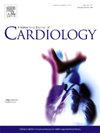心房颤动引起的心源性血栓中cd163阳性巨噬细胞富集比窦性心律引起的动脉粥样硬化血栓中cd163阳性巨噬细胞富集。
IF 3.2
2区 医学
Q2 CARDIAC & CARDIOVASCULAR SYSTEMS
引用次数: 0
摘要
背景:区分动脉粥样硬化性血栓和心源性血栓仍然是一个临床挑战,并使二级预防抗血栓治疗的最佳选择复杂化。目的:本研究旨在探讨推测为动脉粥样硬化(窦性心律,SR)和心源性(心房颤动,AF)血栓的组织病理学差异。方法:血栓中的巨噬细胞(MITO)研究是一项前瞻性观察性研究,研究对象是st段抬高型心肌梗死(STEMI)或栓塞性卒中(ES)患者,这些患者从梗死相关动脉中取出实体血栓。患者被分为两组:SR组(推测为动脉粥样硬化性血栓)和AF组(推测为心源性血栓)。对血栓进行cd163阳性巨噬细胞的免疫组织化学染色,以三分制评分,得分1:在×400上未检测到cd163阳性细胞;评分2:在×400检测到细胞,但在×100检测不到;评分3分:血栓中×100细胞易检出。同时,测定血浆样品中的可溶性CD163。结果:SR组血栓组织cd163阳性细胞的分布与AF组有显著性差异(p )。这些发现提示CD163阳性巨噬细胞在心源性血栓的发病机制中发挥作用,并提高了CD163作为血栓病因学生物标志物的可能性。本文章由计算机程序翻译,如有差异,请以英文原文为准。
CD163-positive macrophage enrichment in cardiogenic thrombi from atrial fibrillation than in atherosclerotic thrombi from sinus rhythm
Background
Differentiating between atherosclerotic and cardiogenic thrombi remains a clinical challenge and complicates the optimal selection of antithrombotic therapy for secondary prevention.
Objectives
This study aimed to investigate histopathological differences between thrombi presumed to be of atherosclerotic (sinus rhythm, SR) and cardiogenic (atrial fibrillation, AF) origin.
Methods
The Macrophage in Thrombus (MITO) study is a prospective observational study of patients with ST-elevation myocardial infarction (STEMI) or embolic stroke (ES), in whom solid thrombi were retrieved from infarct-related arteries. Patients were categorized into two groups: Group SR (presumed atherosclerotic thrombi) and Group AF (presumed cardiogenic thrombi). Thrombi were immunohistochemically stained for CD163-positive macrophages, scored on a three-point scale, score 1: no CD163-positive cell detectable at ×400; score 2: the cell detectable at ×400 but not ×100; score 3: easy to detect the cell in ×100 in the thrombus. Also, soluble CD163 was measured in plasma samples.
Results
The scores of Group SR were significantly lower than those of Group AF (p < 0.01). Plasma level of soluble CD163 (ng/mL) in Group SR was significantly lower than in Group AF [487 (275, 636) vs. 630 (472,780), p = 0.04].
Conclusion
The distribution of CD163-positive cells differed between thrombi from Group SR and Group AF patients. These findings suggest a role for CD163-positive macrophages in the pathogenesis of cardiogenic thrombi and raise the possibility of CD163 as a biomarker for thrombus etiology.
求助全文
通过发布文献求助,成功后即可免费获取论文全文。
去求助
来源期刊

International journal of cardiology
医学-心血管系统
CiteScore
6.80
自引率
5.70%
发文量
758
审稿时长
44 days
期刊介绍:
The International Journal of Cardiology is devoted to cardiology in the broadest sense. Both basic research and clinical papers can be submitted. The journal serves the interest of both practicing clinicians and researchers.
In addition to original papers, we are launching a range of new manuscript types, including Consensus and Position Papers, Systematic Reviews, Meta-analyses, and Short communications. Case reports are no longer acceptable. Controversial techniques, issues on health policy and social medicine are discussed and serve as useful tools for encouraging debate.
 求助内容:
求助内容: 应助结果提醒方式:
应助结果提醒方式:


